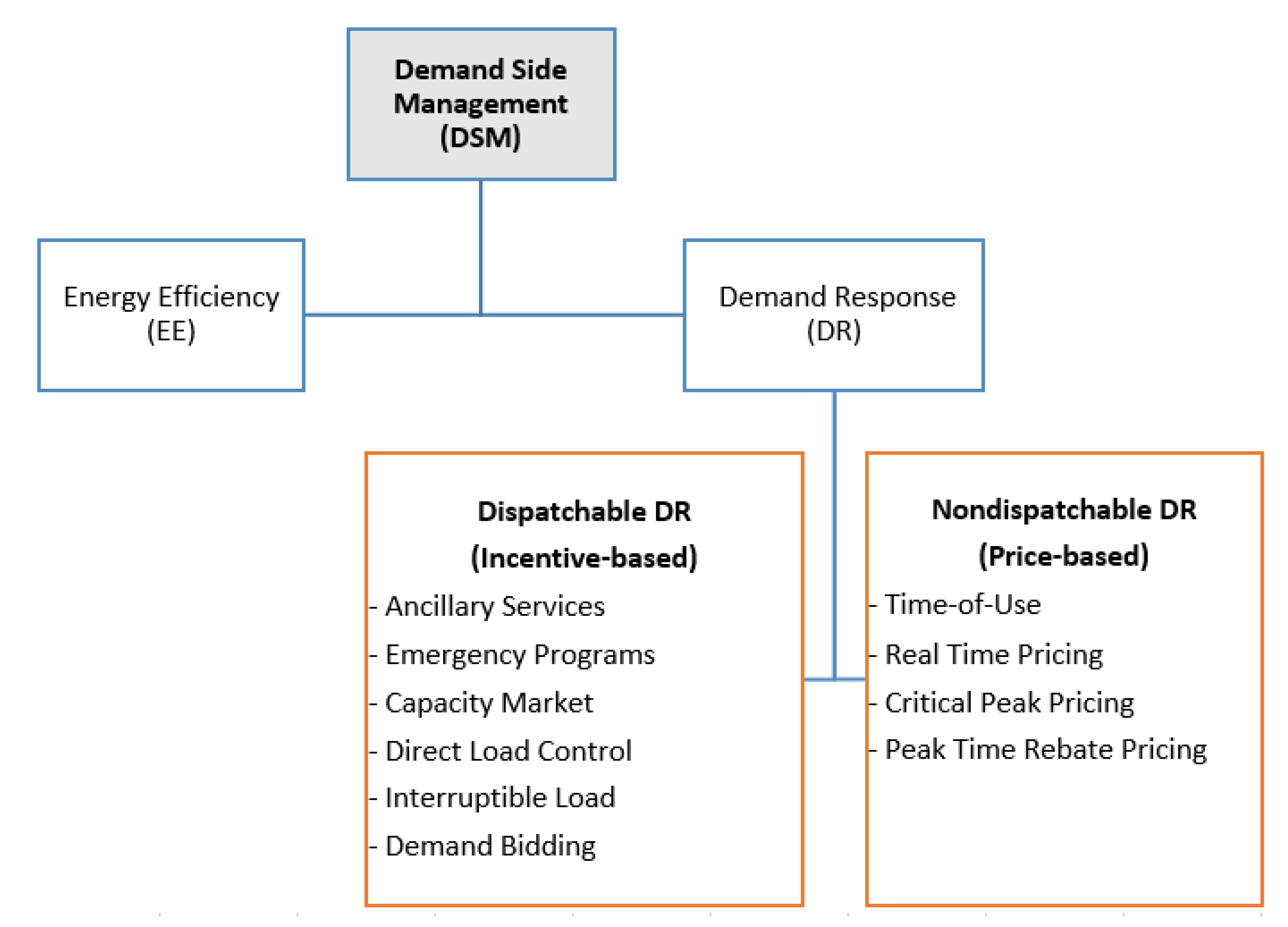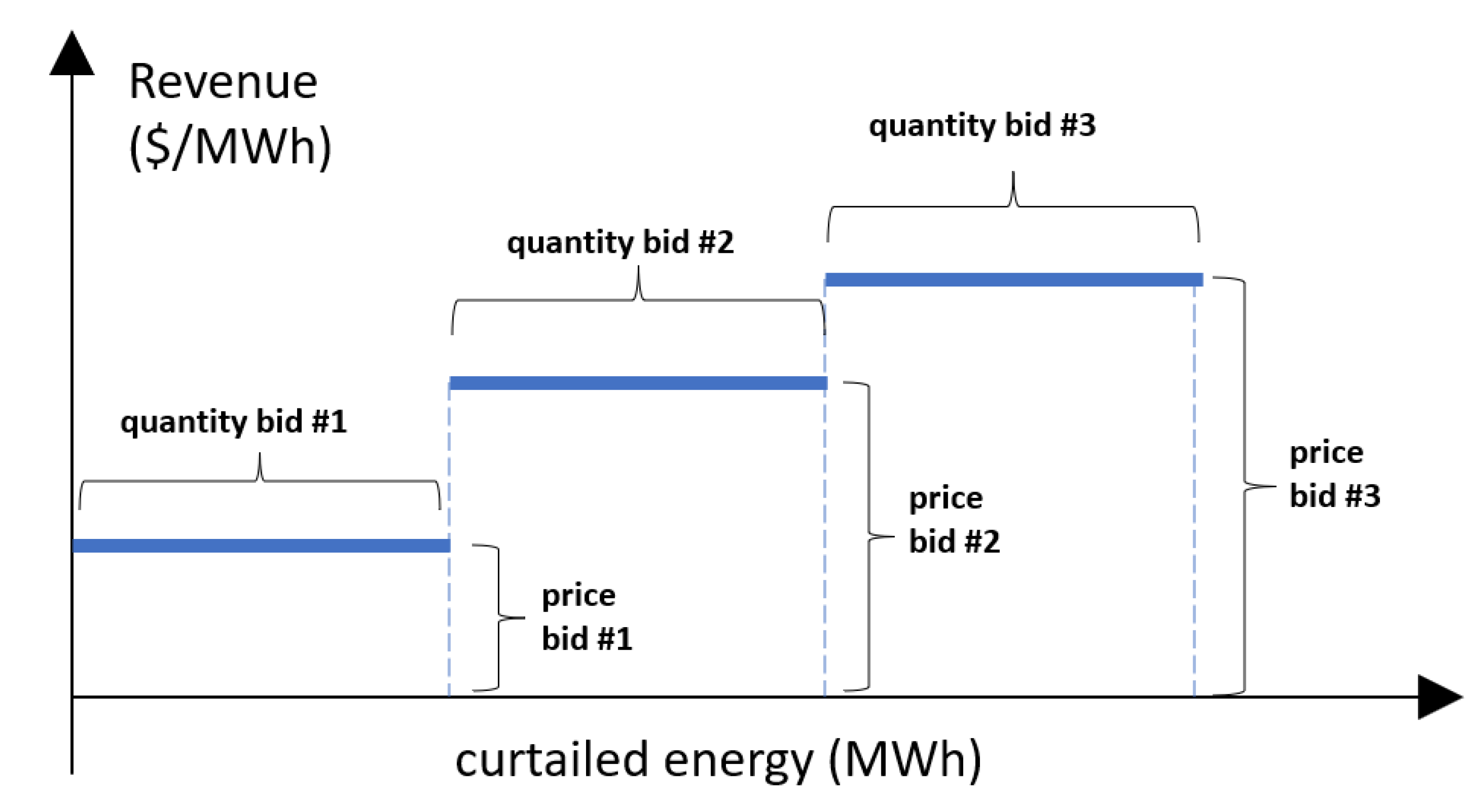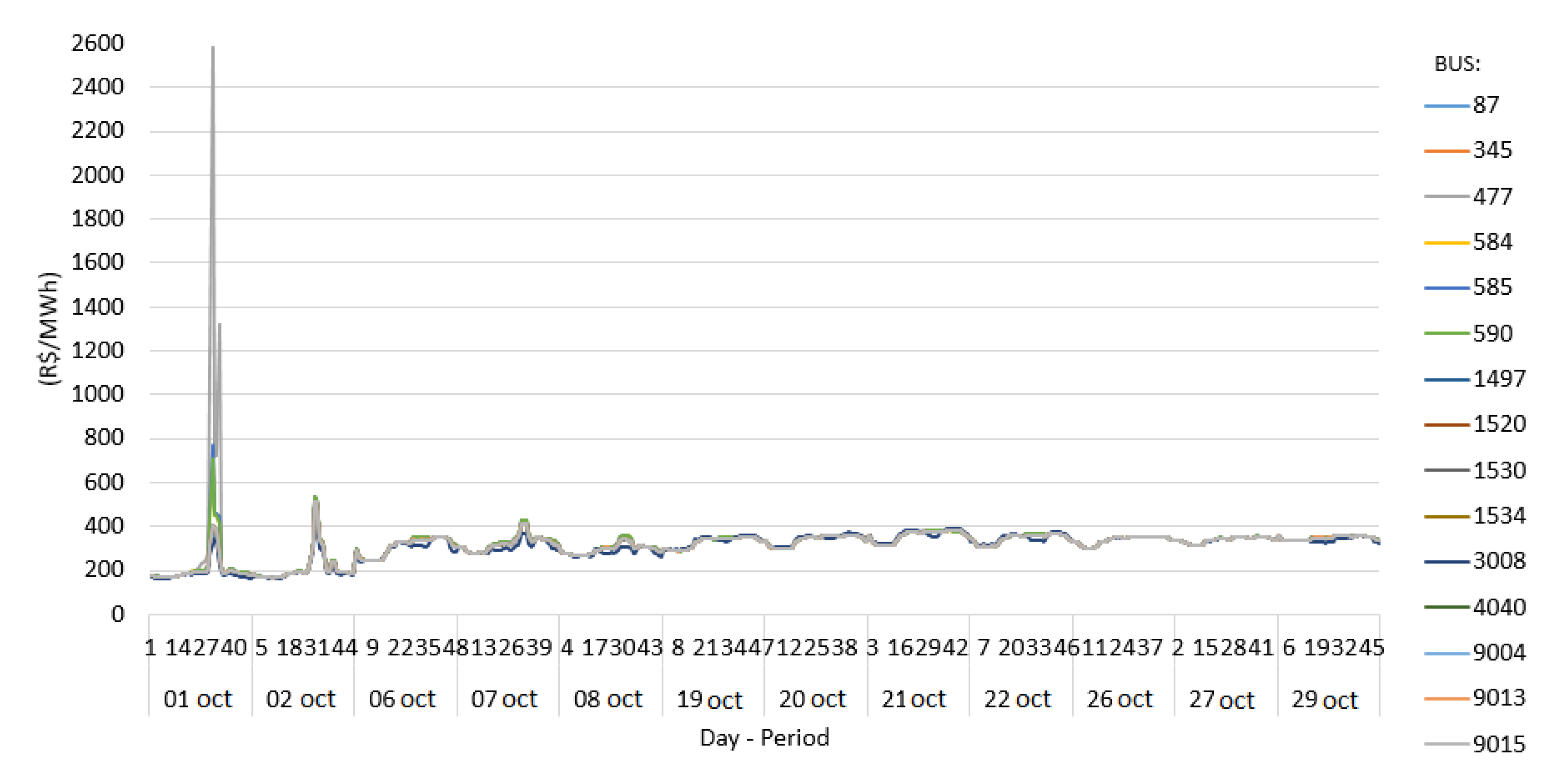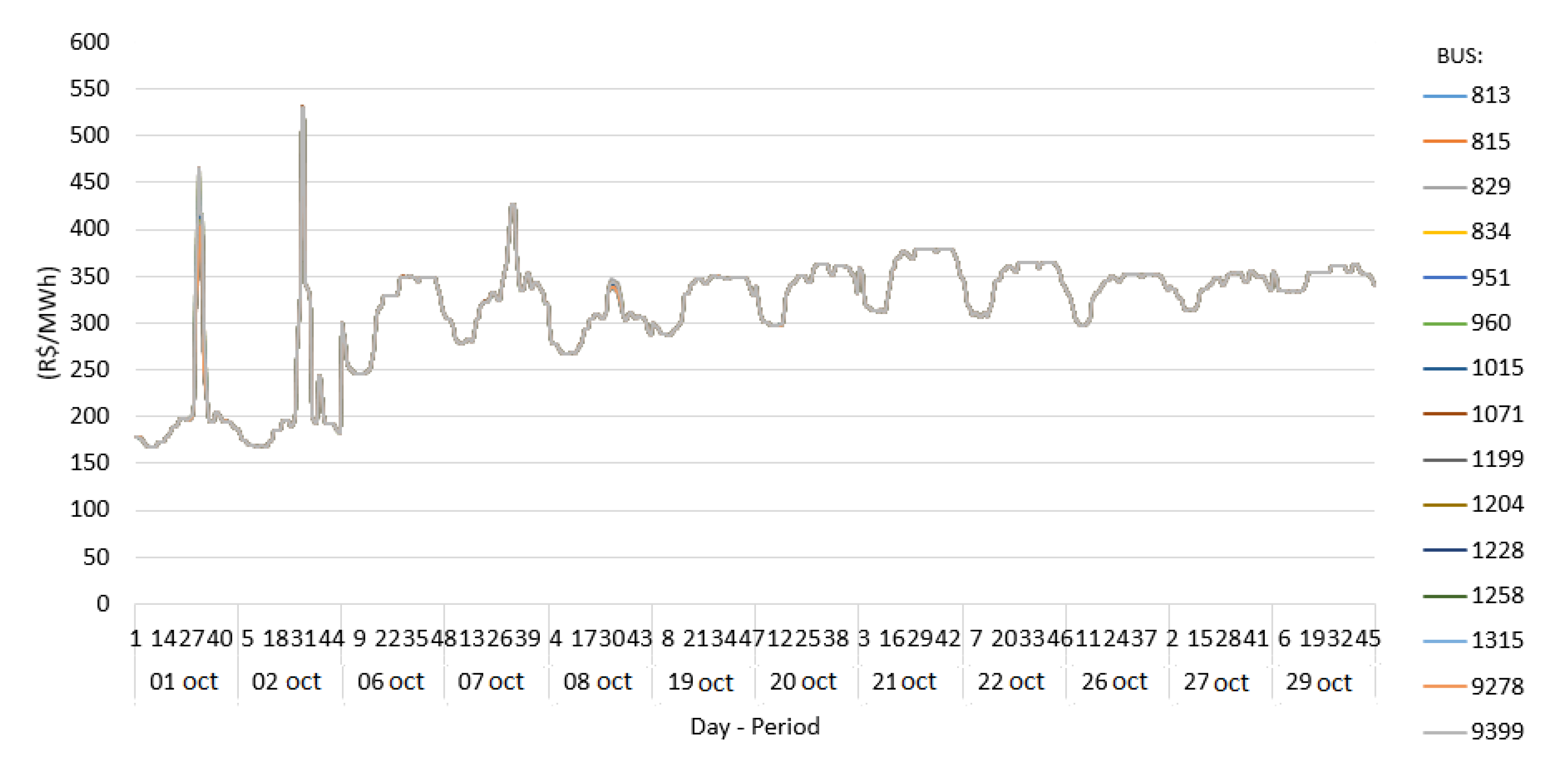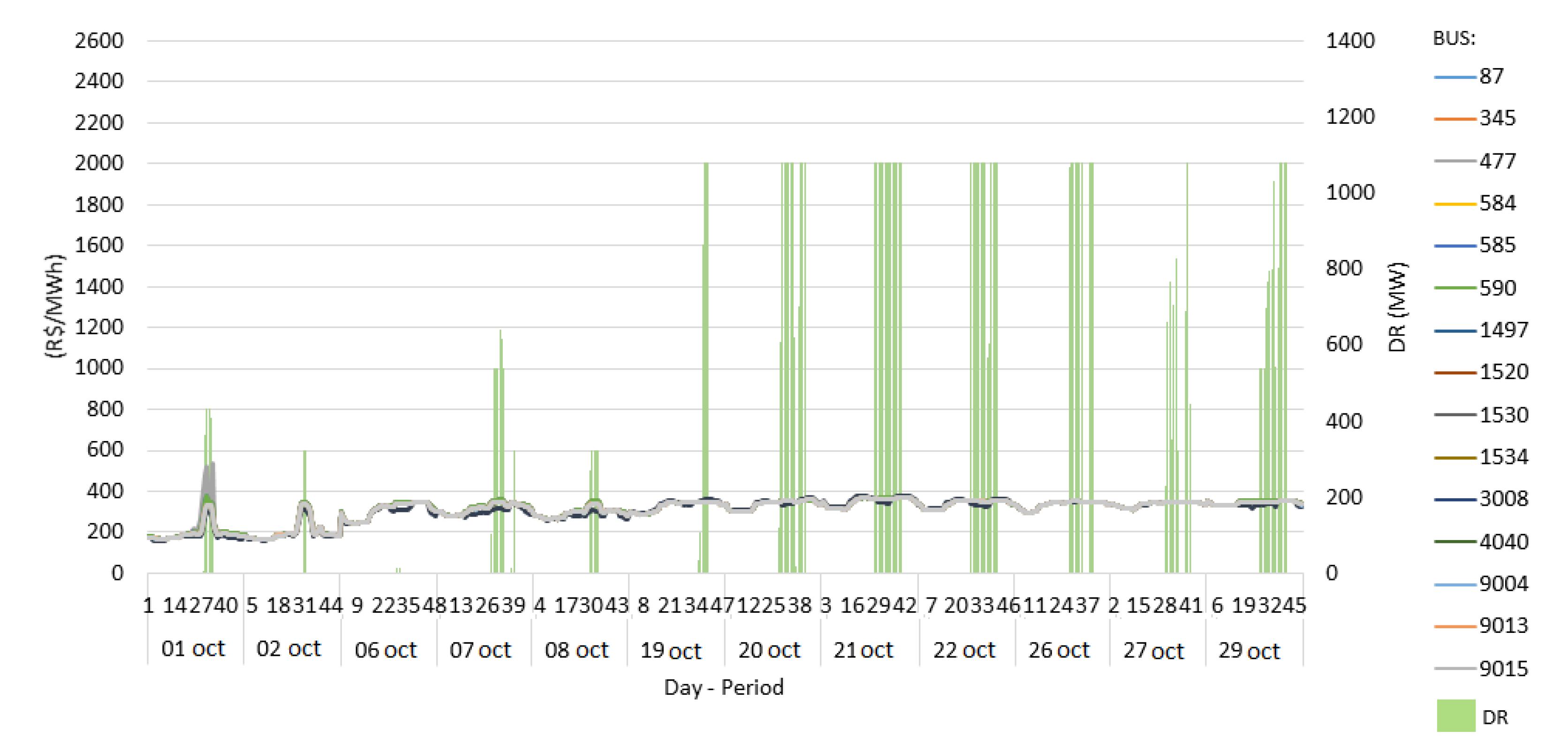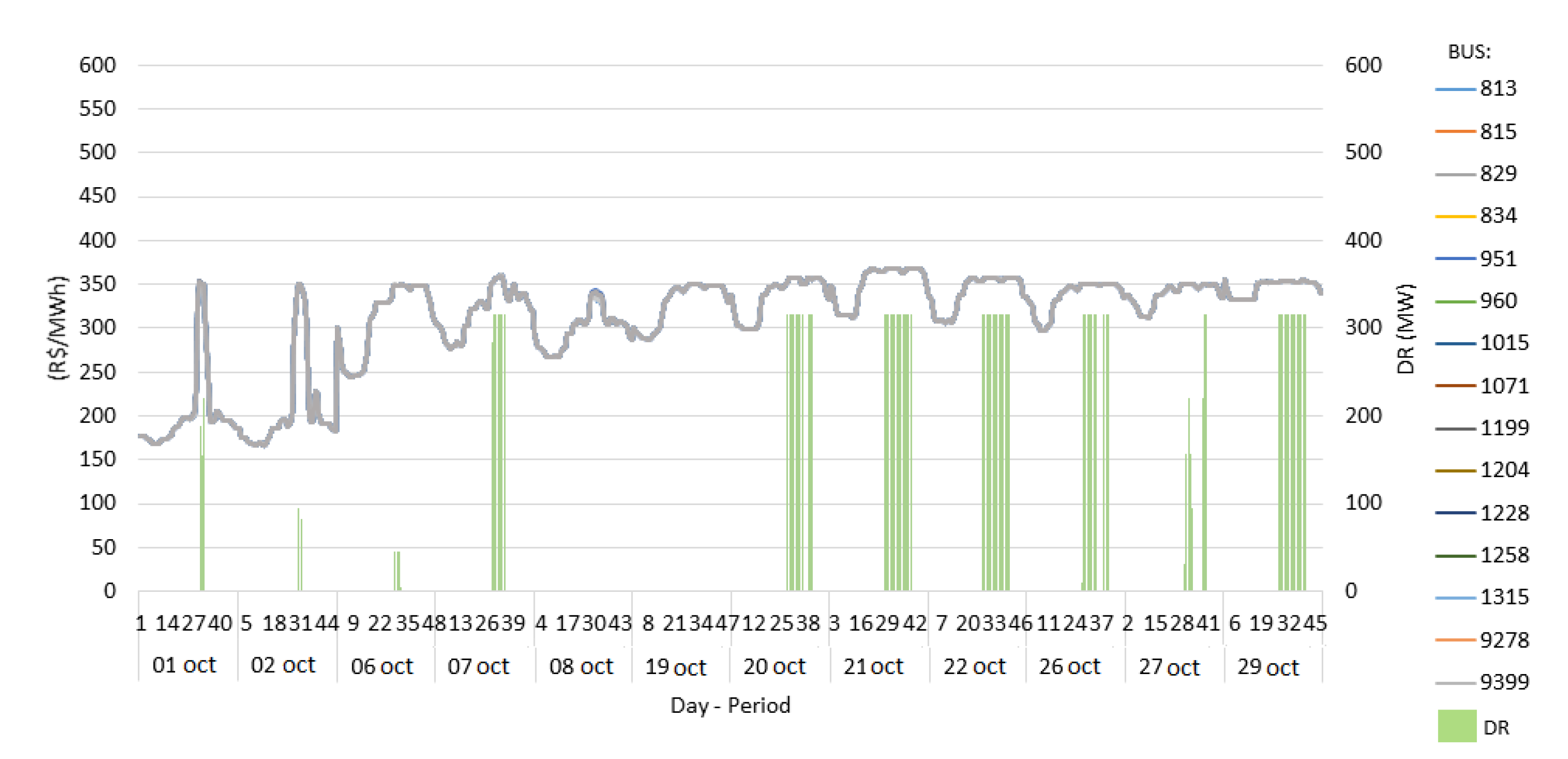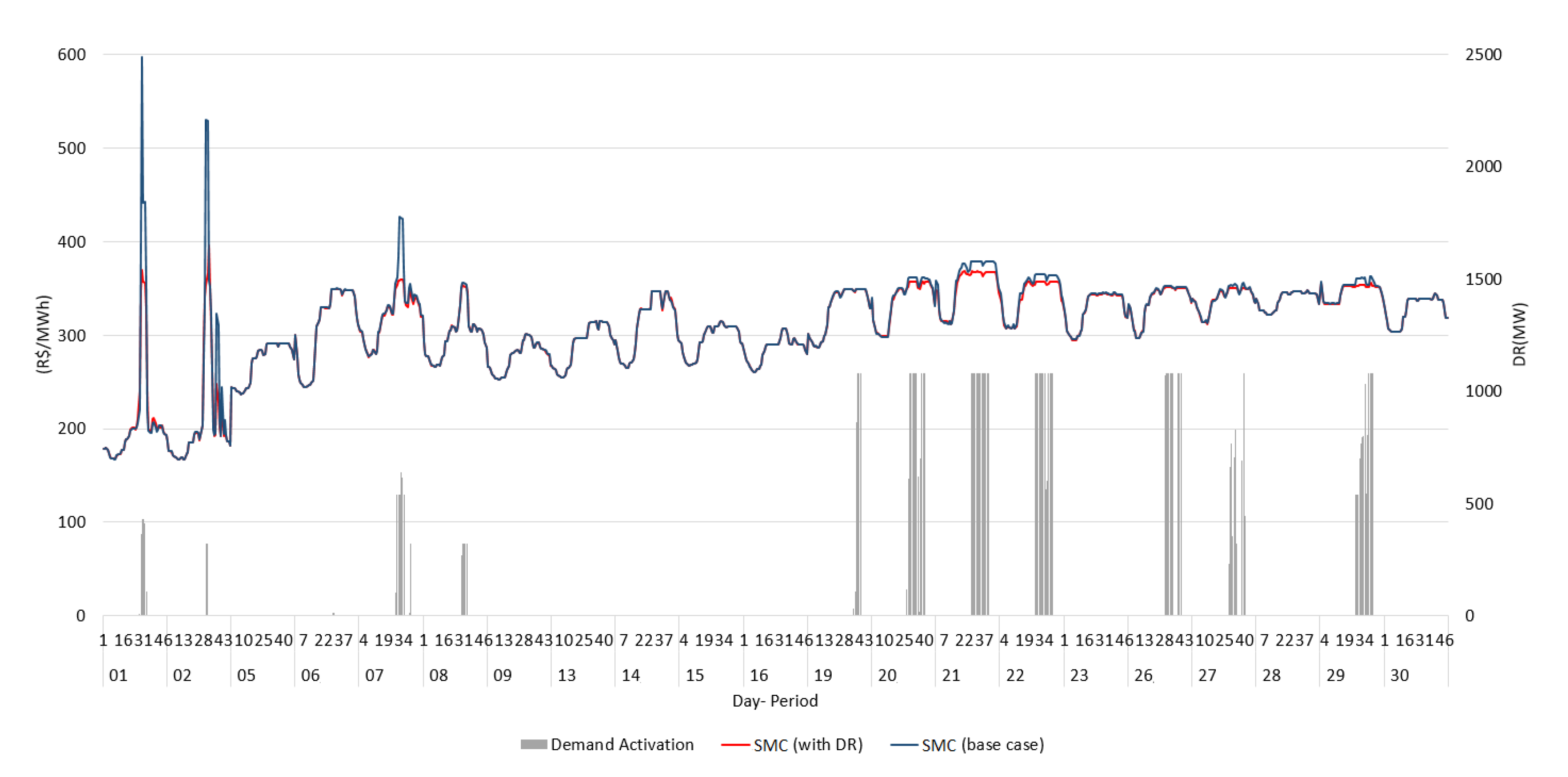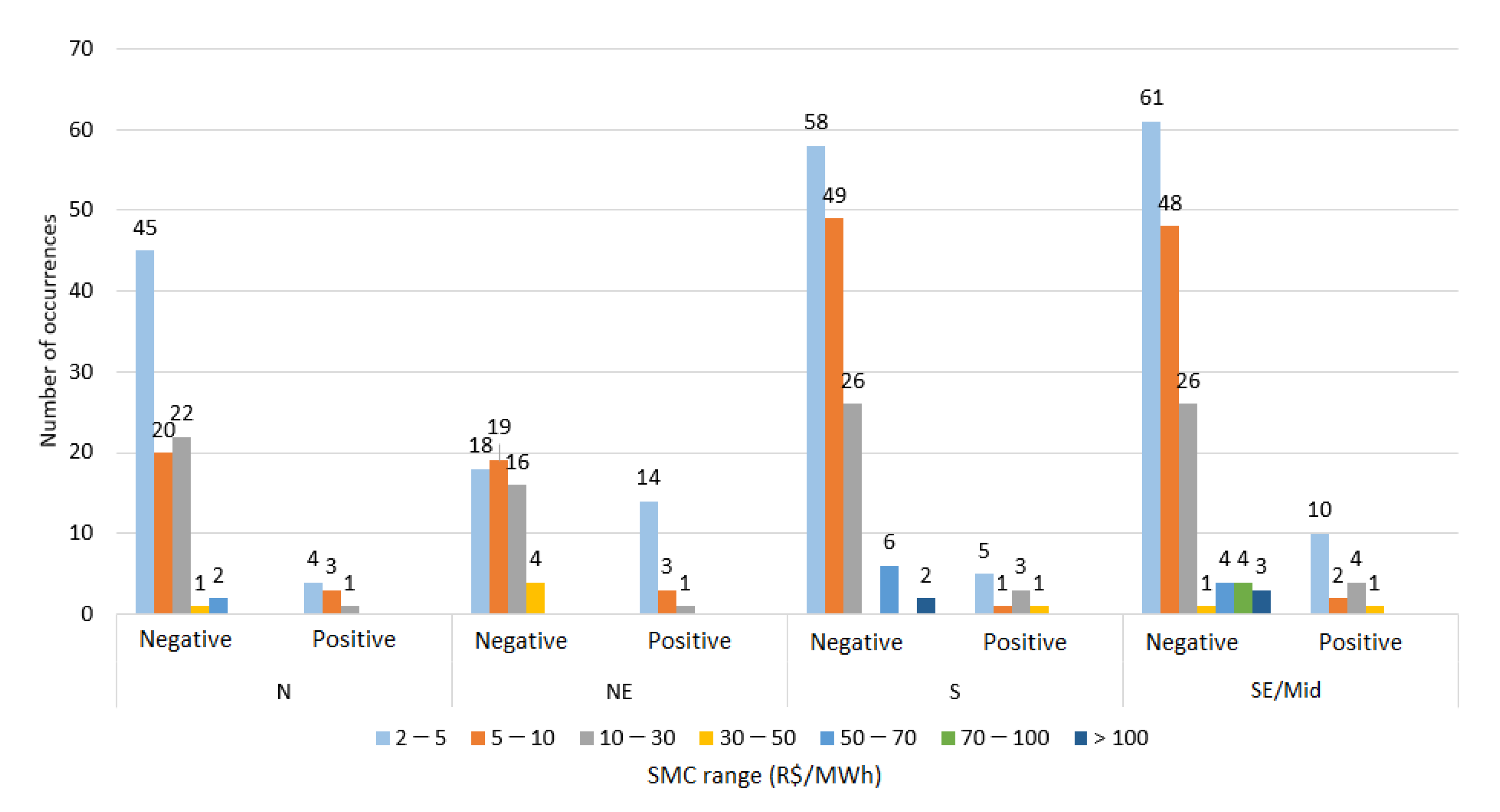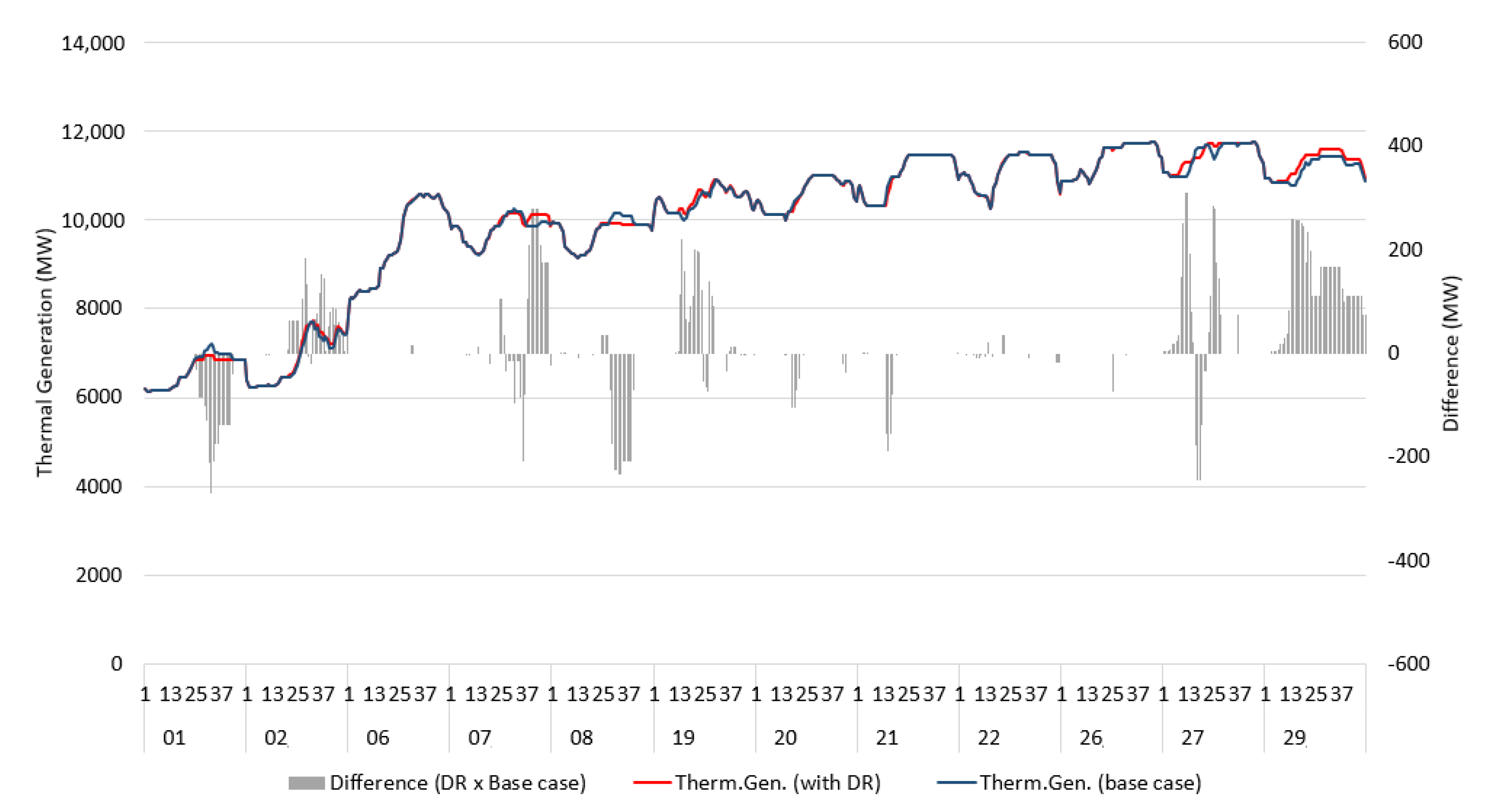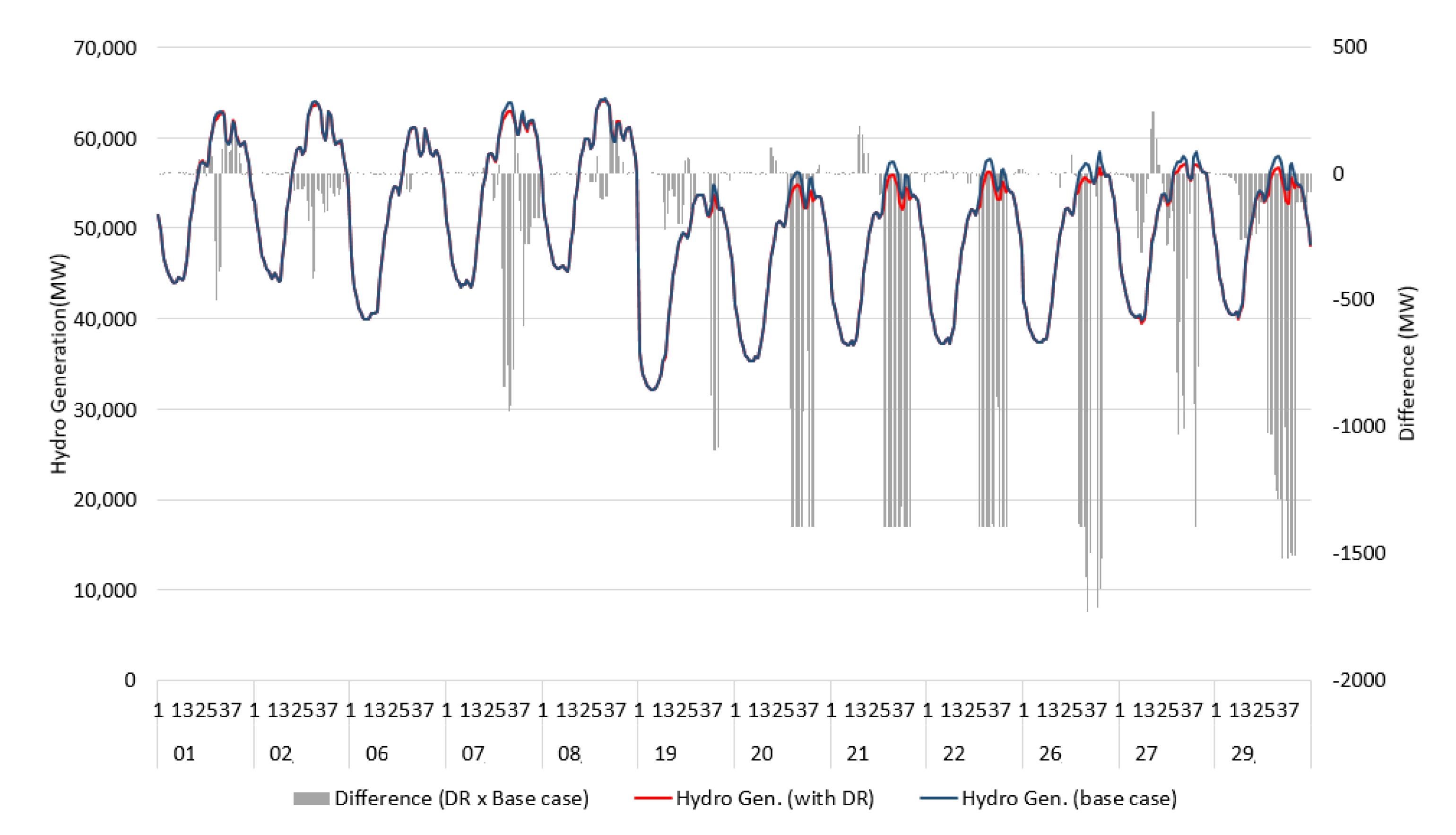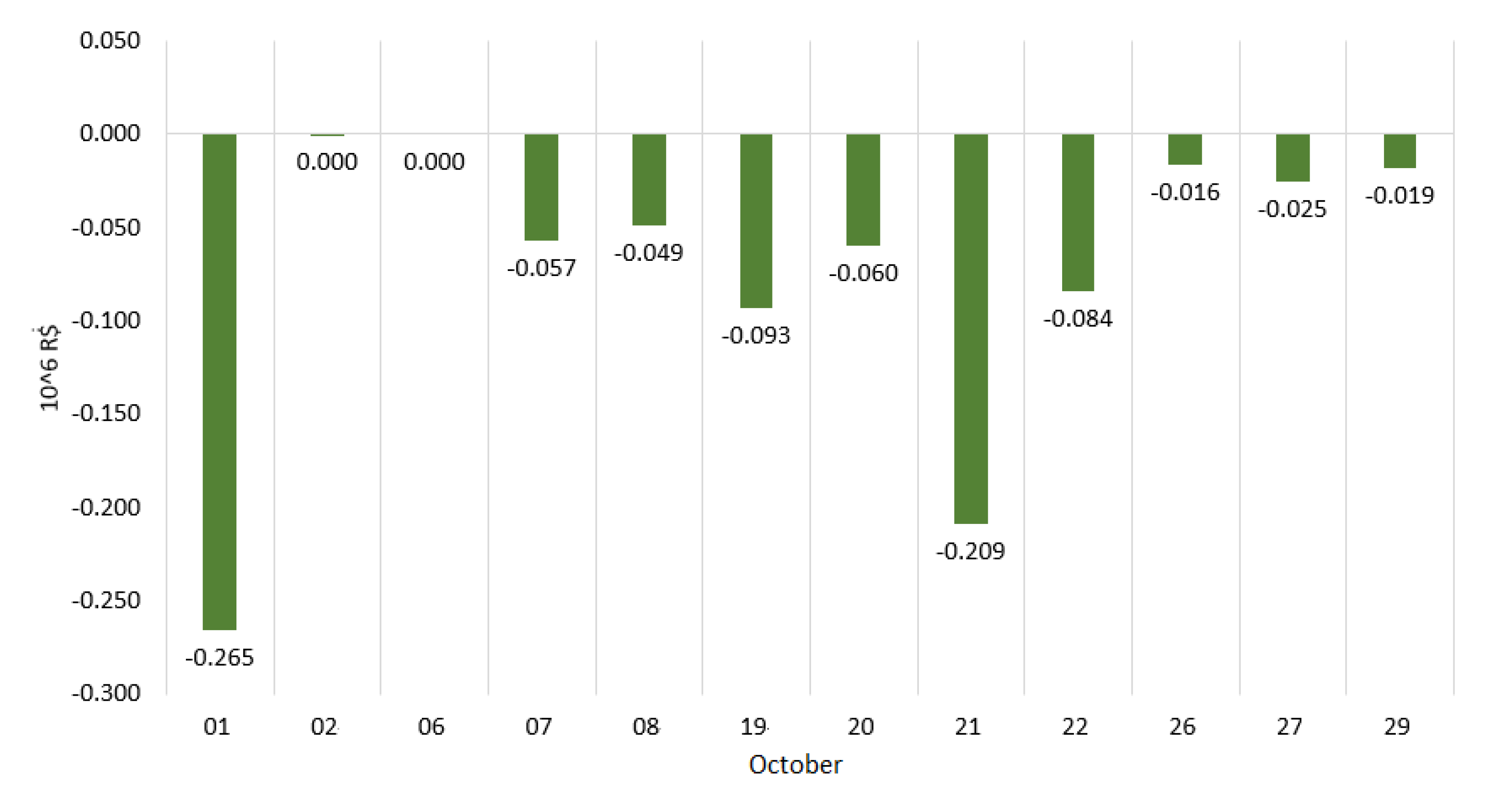1. Introduction
Modern power systems have experienced a large increase in intermittent and non-dispatchable sources–such as wind and solar plants, as well as increasing difficulty in building new hydro plants with large reservoirs for inflow regularization. Therefore, many methods of mitigating the high uncertainty and intermittency of the net load have been proposed in power generation systems to allow a secure and reliable system dispatch in power generation systems. Some resources work on the generation side of the grid, such as pumped storage power plants [
1], energy storage devices [
2], and, more recently, green hydrogen technology [
3]. In such cases, the aim is to store the excess of renewable generation—wind and solar plants in offpeak hours, where energy demand and prices are low, to use them in hours with peak energy and prices, thus yielding a smoother net load pattern and a reduction in generation costs.
Another method of mitigating the high volatility of prices and net load is Demand Side Management (DSM) mechanisms [
4], which involves encouraging consumers to reduce their energy consumption without leaving aside the comfort or stimulating a gradual reduction in consumption by performing the same activities. In terms of the power system operation, the main goal is to motivate a shift in the load consumption behaviour of consumers from peak hours to low level hours, or even a load reduction in exchange for lower energy prices.
In general, DSM can be divided in two main categories: Energy Efficiency (EE) and Demand Response (DR). The main purpose of EE is to reduce energy net consumption while accomplishing the same tasks, while DR refers to load profile adjustments, as, for example, load shifting and load shedding, which are driven by market incentives [
5]. An extensive literature survey is provided, for example, in [
6], which presents, among other things, recent developments of the DSM of electrical power systems, as well as in [
7], which shows a survey on methods for optimization of the demand response.
Figure 1 presents the main categories of DSM, separated by EE and DR, which represent only some of the many existing DSM programs in the energy markets around the world [
8,
9].
DSM mechanisms are widely considered in several energy markets, such as the US, Spain, and France [
10,
11], and represent an important tool to provide adequate expansion of the electricity system as well as to help increasing the reliability and security of the energy supply system in many countries. The work [
12] studies the application of DR in security constrained problems, while [
13] assesses the application of DR in the context of profit maximization in electricity markets. In [
14], some methodological and practical aspects of the inclusion of DR in energy optimization problems are discussed.
Contributions of This Work
This work presents a thorough and realistic analysis of a mixed integer linear programming (MILP) formulation to model DR as a dispatchable resource, taking into account minimum load curtailment constraints, minimum up/down load deduction times, as well as piecewise linear bid curves for load shedding in eligible loads. Although the situation of demand retrieving the decreased consumption in later hours is an important analysis, this possibility was not considered in this work.
The methodology was implemented in the network-constrained hydrothermal unit commitment model named DESSEM, which is officially applied in Brazil for the day-ahead scheduling and hourly price setting [
15]. In this sense, the contributions of this work are twofold: (i) to show the benefits of the application of DR programs even in predominantly hydro systems, by assessing the impact on energy prices and generation cost in real and official cases of day-ahead scheduling and pricing in Brazil. To the best of the authors’ knowledge, the few works that apply DR models to generation scheduling problems are restricted to pure thermal systems or to hydrothermal systems with a configuration much smaller and/or a representation of hydro, thermal, or network constraints less accurate as compared to [
15]. The work [
16] studied the hydrothermal generation scheduling with the inclusion of pumped storage-hydraulic units with DSM. In [
17], an optimization model is proposed to smooth frequent local load fluctuations, and [
18] studied the minimization of wind energy curtailment by scheduling DR, in such a way that higher values of demand match high wind generation values. The work [
19] proposes an integrated stochastic scheduling model to dispatch resources considering both gas operation and the demand side to meet renewable energy intermittence; (ii) to present a MILP-based DR model that is able to provide results in reasonable CPU times in a real large-scale system, with over 160 hydro plants and 12,000 transmission lines, and taking into account 60 DR units grouped in 4 aggregators. The results assessed the amount of reduction in operational costs and the positive impact in mitigating peak values of energy prices, as well as reducing hydro generation, helping to preserve the reservoir levels.
2. Demand Response Programs
According to the International Energy Agency (IEA), DR programs have the potential to substantially improve power market flexibility and efficiency, delivering a range of benefits including more efficient market clearings, lower system prices, a decrease in peaking plant investment requirements, and greater flexibility with the potential to improve power system security [
20].
The participation of several customer classes (residential, industrial, commercial, and transportation) in DR programs, which is facilitated by the large penetration of smart meters, combined with the high requirement for energy, have made the DR market in USA the largest in the world. According to the Federal Energy Regulatory Commission’s (FERC) 2019 report [
10], in 2018, the USA had a participation in DR programs of around 29.7 GW among its System Operators (SO), representing 6.0% of the average peak load.
In Europe, many countries had already adopted consumer policy to be included as a mechanism to mitigate peak demand and delay the system expansion. France has consolidated DR mechanisms, such as balance mechanisms, capacity markets, among others, and had a total share in DR market in 2018 of around 48.9 GWh [
21]. DR mechanisms in Spain are mostly composed of real-time pricing and interruptibility programs, where the latter is aimed at emergency situations when energy supply is insufficient to meet demand, and had a capacity to a reduce peak hour demand of 2000 MW in 2017 [
11]. Norway encouraged specific programs aimed at delaying network expansion with the following results: a 10% reduction in peak demand in Oslo, increased knowledge about consumer behavior, and model development for DSM mechanisms [
22].
DR mechanisms are structured in different regions of the world. In [
23], an overview of the demand reaction in developing countries such as Chile and Colombia is presented. The DR market in countries such as Japan, China, and North Korea, as well as continents such as Africa and Oceania, has an extensive survey carried out in [
24], indicating, in addition to the current panorama, the main barriers for introduction of DR programs in these regions. A study of the DR programs associated with renewable energies was analysed in [
25] to explore an appropriate instrument to help system operators considering the increase in sustainability of worldwide electrical systems.
As can be seen in the DR literature and illustrated by
Figure 1, DR programs can be proposed mainly in two ways [
11,
20]:
dispatchable DR programs: allow the system operator to decide the dispatch of these loads based on bid curves for remuneration of loads according to the amount of load deduction. They are also known as an incentive-based DR program, in which consumers can receive payments to change their consumption patterns triggered by, for instance, high clearing market prices.
non-dispatchable DR programs: where loads provide a long-term reduction in their pattern according to the behavior of prices (price-based DR program). Consumers can respond to wholesale market price variations or dynamic grid fees.
We considered in this study the first case, where the load can be deducted based on piecewise linear bid curves for load shedding in eligible loads.
3. Network-Constrained Hydrothermal Unit Commitment Problem (Nchtuc)
We considered a MILP-based NCHTUC problem on a cost minimization basis, whose formulation is summarized below. Due to space limitations, we refer to [
15] for mathematical details and a richer description of constraints of the model, which is the one officially used for dispatch and price setting in Brazil and which was used in this work to model the DR as a dispatchable resource.
The objective Function (
1) is to minimize total system operation costs
Z, given by:
where
is the number of thermal units, each one with a generation
subject to linear or piecewise linear fuel costs given by
. The “status-change” cost
for thermal units comprises both startup and shutdown costs, which are a function of units status
. The terms
and
refer to imported and exported energy, respectively, with neighborhood systems, whose unitary prices are given by
(
) for each of the NCI (NCE) import (export) contracts. The term
is the expected future operation cost, which depends on the vector of end storages
and the amount of water in the river courses
at the end of the time horizon (see [
26] for details). Such a function is provided by the mid-term model [
27].
The electrical network is represented by a linearized dc model, where reactive power is neglected and line flows are given by taking into account the first and second Kirchhoff laws, based on the reactance values for each transmission line, which are given data. The network model considered in this study includes, besides the energy balance constraints in each node, line flow limits in each transmission lines (
2) as well as additional security constraints (
3) [
28].
where
is the flow limit in each line
l,
represents generation and load in each bus, and
are the participation factors that depend on the network topology. The parameters
,
,
, and
of security constraints are provided by the system operator. The symbols with lower and upper bars in the left and right hand sides of (
2) and (
3) represent minimum and maximum values for the corresponding expressions. Additionally, additional security constraints given by tables or piece-wise linear functions are included in the model, as described in [
15].
The hydro balance in the reservoirs is formulated as (
4):
where the known values are the natural inflows
to reservoirs and water intakes
for other uses of water. Variables
and
are the turbined (discharge) and spilled outflows, and
is the evaporation function of the reservoir, which is described in [
15]. The sets
indicate upstream/downstream pumping stations that take water from/to reservoir
i, and
are the set of upstream plants
j with/without water delay time to reservoir
i, with a value of
in the first case. The factor
converts the average values of the variables in
during interval
t in the total amount of volume of water in interval
t,
, taking into account the duration of the interval.
The hydro generation
for plant
i is a concave piecewise-linear function
, whose expression is presented in [
15], and the method of construction is presented in [
29].
Thermal unit commitment constraints include: minimum generation (once turned on), startup/shutdown curves, minimum up/down times, maximum up and down ramp rates, and a detailed modeling of combined cycle units by a component-based model. The formulation of all these constraints is presented in [
15].
Finally, a large number of operating constraints for the reservoirs are included in the model, as also detailed in [
15].
5. DR Characteristics
The study was applied to the real data for the hydrothermal Brazilian system and its pilot DR program. The system is divided into four subsystems: Southeast/Midwest, South, Northeast, and North. We considered 15 DRs (DR loads) per subsystem, each one with minimum and maximum reduction values (once activated) and Ton/Toff values given in
Table 1.
Aggregators were modeled according to the following criteria:
For each subsystem, a maximum activation limit to the set of 15 DRs was settled, reaching the limit value of 1.8 GW for a total reduction of all DRs in the system.
This value corresponds to 10% of the Brazilian wholesale market, which can freely negotiate their energy purchase contracts and represents the most prepared consumer market to participate in demand response incentive programs.
This relatively large amount of DRs with a wide range of variation in load reduction allows more flexibility for the results of the day-ahead dispatch model and enlarges its decision-making capacity in determining the optimal dispatch. The lower/upper limit constraints for the ECs of each aggregator are shown in
Table 2.
The cost of each DR offer was USD 62.3/MWh (currency conversion from real (R$) to dollar (USD). 1 R$:USD 5.62 ) to all subsystems. The average marginal operational cost to the simulated period was of around USD 55/MWh to the Southeast/Midwest and South subsystems, USD 34/MWh to the Northeast subsystem, and USD 41/MWh to the North subsystem.
7. Conclusions
This study assessed the impact of considering demand response (DR) loads as dispatchable resources in hydrothermal dispatch, even for predominantly hydro systems. Numerical experiments were performed for the real large-scale Brazilian system, where DR loads and constraints were implemented in the mixed-integer linear programming-based network-constrained hydrothermal unit commitment model officially used by the Independent System Operator and the Market agency for the day-ahead system dispatch and hourly price setting.
Based on the analysis results of marginal costs for each bus (BMC) and the average marginal cost for each subsystem (SMC) in which the system is divided, we concluded that the main benefit of the DR dispatch was to attenuate the peak values both for BMC and SMCs, which occurred at hours where the DR activation was allowed and whose energy requirements to meet demand proved to be more expensive. As a result, the DR dispatch allowed a reduction in the system operation cost by decreasing the load curve in peak demand hours.
Moreover, with the application of DR there was a systematic reduction in hydro generation throughout the system, whereas the thermal dispatch varied from increasing in one region and decreasing in another one, depending on the case and system conditions. Finally, it was observed that the total operational cost of system was reduced, not only due to a decrease in present costs along the day but also by reducing the expected value of future costs, due to the higher storage in the reservoirs at the end of the day, yielded by the application of DR program.
As a final conclusion, we confirmed the feasibility of representing DR as a dispachable resource in the Brazilian system, with benefits in system operation cost and security of supply. The main limitation of this study is that we considered only the possibility of load reduction. For loads that are flexible in terms of the time window of application but cannot be curtailed, load shifting should be modeled, which was beyond the scope of the study. In this sense, in future works, we intend to assess the benefits/impacts of alternative/additional rules that may be considered for the DR program, such more rigid constraints for load reduction and the possibility of load shifting. In the work [
14], modeling approaches for load shifting, either in a more flexible way or in fixed "load blocks" with the use of mixed integer linear programming techniques, are discussed and can be included in hydrothermal scheduling problems, such as the one considered in this study.
